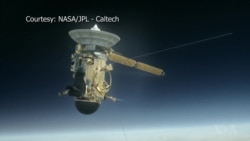ມີການສະແດງຄວາມດີໃຈຈົນນ້ຳຕາອອກ ການໂອບກອດແລະການສະເຫຼີມສະຫຼອງ
ເພື່ອເປັນຂີດໝາຍ ຂອງການສິ້ນສຸດລົງ ໃນການປະຕິບັດງານເປັນເວລາ 20 ປີ ຂອງ
ຍານອະວະກາດ Cassini ທີ່ດາວພະເສົາ.
ສູນກາງຄວບຄຸມການປະຕິບັດງານ ທີ່ຫ້ອງວິໄຈແຮງຂັບເຄື່ອນຈະຫຼວດຂອງອົງການ ອະວະກາດຫຼື NASA ຂອງສະຫະລັດຢູ່ທີ່ລັດກາລີຟໍເນຍຈະໄດ້ຍິນສຽງປະກາດຂອງ
ຜູ້ຈັດການໂຄງການ Cassini ທ່ານ Earl Maize ທີ່ກ່າວວ່າ “ສັນຍານຈາກຍານອະ
ວະກາດຫາຍໄປແລ້ວແລະພາຍໃນ 45 ວິນາທີຂ້າງໜ້າ ຍານລຳນີ້ກໍຈະຫາຍໄປເຊັ່ນ
ດຽວກັນ.”
ໃນກອງປະຊຸມຖະແຫຼງຂ່າວຫລັງຈາກນັ້ນ ທ່ານ Maize ໄດ້ສະແດງຄວາມປະທັບໃຈ
ໃນຜົນສຳເລັດຂອງຍານ Cassini.
ທ່ານກ່າວວ່າ “ໃນເຊົ້າມື້ນີ້ ຍານສຳຫຼວດ ຊຶ່ງເປັນເຄື່ອງຈັກ ທີ່ເຮັດຂຶ້ນໂດຍມະນຸດໄດ້
ສຳເລັດເສັດສິ້ນການປະຕິບັດງານ ທີ່ຢູ່ໄກອອກໄປຕັ້ງ 900 ລ້ານໄມລ໌. ການສັງເກດ
ການທີ່ໃກ້ທີ່ສຸດ ບໍ່ຮູ້ວ່າແມ່ນຫຍັງໄດ້ເກີດຂຶ້ນຈົນເທົ່າ 84 ນາທີຕໍ່ມາທີ່ຍານ Cassini
ໄດ້ຫາຍໄປແລ້ວ. ຈົນເທົ່າວິນາທີສຸດທ້າຍ ຍານດັ່ງກ່າວ ໄດ້ເຮັດທຸກຢ່າງທີ່ພວກເຮົາ
ໄດ້ສັ່ງໃຫ້ເຮັດ.”
ຍານ Cassini ຖືກສົ່ງຂຶ້ນສູ່ອະວະກາດໃນປີ 1997 ແລະການເດີນທາງໄປດາວພະ
ເສົາ ໃຊ້ເວລາເຖິງ 7 ປີ.
ນາງ Linda Spilker ນັກວິທະຍາສາດຂອງໂຄງການ Cassini ກ່າວວ່າ “ເມື່ອຂ້ອຍ
ເບິ່ງຄືນຫລັງກ່ຽວກັບໂຄງການຍານ Cassini ແລ້ວ ຂ້ອຍມອງເຫັນວ່າການປະຕິບັດ
ງານໄລຍະຍາວ ເປັນເວລາ 13 ປີ ໃນການຄົ້ນພົບ ທາງວິທະຍາສາດ ແລະ ການໂຄ
ຈອນຮອບສຸດທ້າຍ ແມ່ນເປັນພຽງແຕ່ການແຂ່ງຂັນຮອບສຸດທ້າຍເທົ່ານັ້ນ.”
ຍານ Cassini ໄດ້ສຳຫຼວດເບິ່ງດາວພະເສົາ ແລະເດືອນບາງໜ່ວຍຂອງດາວດັ່ງກ່າວ
ແລະກໍໄດ້ທຳການຄົ້ນພົບສິ່ງໃໝ່ໆ ໃນລະຫວ່າງການປະຕິບັດງານ.
ຜູ້ອຳນວຍການຫ້ອງວິໄຈແຮງຂັບເຄື່ອນຈະຫຼວດຂອງອົງການອະວະກາດຫຼື NASA
ຂອງສະຫະລັດທ່ານ Michael Watkins ກ່າວວ່າ “ການຄົ້ນພົບຂອງຍານ Cassini
ໃນລະຫວ່າງທີ່ຢູ່ໃນວົງໂຄຈອນເປັນເວລາ 13 ປີ ແມ່ນໄດ້ຂຽນປື້ມໃໝ່ ກ່ຽວກັບດາວ
ພະເສົາ ຊຶ່ງໄດ້ຄົ້ນພົບໂລກ ທີ່ອາດດຳລົງຊີວິດຢູ່ໄດ້ແລະໃຫ້ການຄ້ຳປະກັນວ່າ ພວກ
ເຮົາຈະກັບຄືນໄປຍັງດາວທີ່ມີວົງແຫວດັ່ງກ່າວອີກ.”
Tears, hugs and celebrations marked the end of a 20-year mission to Saturn for the spacecraft Cassini.
In mission control located at NASA's Jet Propulsion Laboratory in California, Cassini Program Manager Earl Maize's voice was heard loud and clear: "The signal from the spacecraft is gone, and within the next 45 seconds so will be the spacecraft."
In a press conference afterwards, Maize paid tribute to Cassini.
"This morning, a lone explorer, a machine made by humankind finished its mission 900 million miles away. The nearest observer wouldn't even know until 84 minutes later that Cassini was gone. To the very end the spacecraft did everything we asked," he said.
Launched in 1997, Cassini's trip to Saturn took seven years.
"When I look back at the Cassini mission, I see a mission that was running a 13-year marathon of scientific discovery, and this last orbit was just the last lap," Cassini project scientist Linda Spilker said.
Saturn and its moons
Cassini has been exploring Saturn and some of its moons making discoveries along the way.
"The discoveries that Cassini has made over the last 13 years in orbit has rewritten the textbooks of Saturn, have discovered worlds that could be habitable and have guaranteed that we'll return to that ringed world," Jet Propulsion Laboratory Director Michael Watkins said.
Cassini discovered ocean worlds on the Saturn's moons Titan and Enceladus. Cassini also detected strong evidence of hydrothermal vents at the base of Enceladus' ocean.
These discoveries prompted the decision to destroy Cassini as it ran out of fuel, so there is no risk of contaminating these moons with bacteria from Earth.
In its last hours, Cassini took final images, including Enceladus setting behind Saturn, Saturn's rings, Titan's lakes and seas, and an infrared view of Saturn.
As Cassini plunged into Saturn, its sensors experienced the first taste of the planet's atmosphere, sending critical information to Earth until it disintegrated.
"It just really tells us about how Saturn formed and the processes going on and really how all the planetary bodies in our solar system have formed," said Nora Alonge, Cassini Project science and system engineer.
Bitter sweet moment
The final moments of the spacecraft has been a bitter sweet moment for Alonge who has been working on the Cassini mission for more than a decade.
"I'm feeling so many emotions. I'm very proud and I'm honored to be part of such an amazing mission, such a fruitful scientific mission, an engineering feat for a robust spacecraft that has lasted for so long, and of course I'm sad," she said. "I feel like I've lost a friend. We've been talking to Cassini for years. We check on the health and safety. It talks back to us and gives us data. That'll be missed. It'll be a big change for many of us."
"This, this has truly been beyond my wildest dreams," said Julie Webster, Cassini's spacecraft operations manager. She has been with this mission since Cassini was built.
The members of the Cassini mission team said the end of the spacecraft was picture perfect.
"We found the best possible solution to get scientific data that would have been too risky to take at any other time by diving between the planet and the rings. We're going into a region we could have never explored before. Cassini is becoming now a part of Saturn and it's the perfect ending point," Alonge said.
Scientists said the end of Cassini also marks the beginning of other planetary explorations and more discoveries as scientists continue to analyze the unprecedented data of Saturn collected by Cassini.






